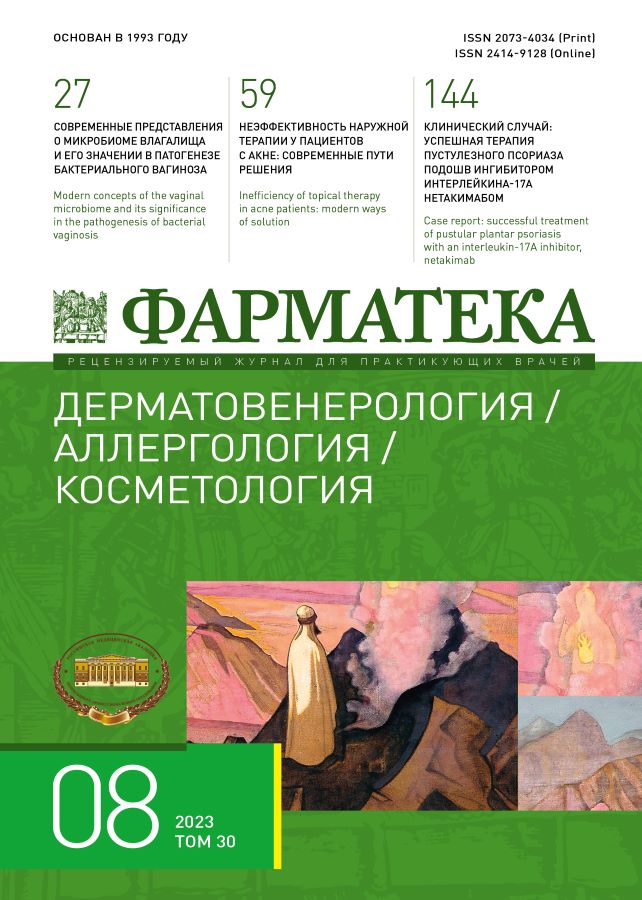Modern approaches to the treatment of severe forms of ichthyosis in children
- Авторлар: Botkina A.S.1,2, Gumennaya E.R.2, Dubrovskaya M.I.1
-
Мекемелер:
- Pirogov Russian National Research Medical University
- Russian Children’s Clinical Hospital
- Шығарылым: Том 30, № 8 (2023)
- Беттер: 110-115
- Бөлім: Problem
- URL: https://journals.eco-vector.com/2073-4034/article/view/623142
- DOI: https://doi.org/10.18565/pharmateca.2023.8.110-115
- ID: 623142
Дәйексөз келтіру
Аннотация
Congenital ichthyoses are a heterogeneous group of hereditary cornification disorders of varying severity, characterized by generalized desquamation, hyperkeratosis, and often inflammation of the skin. Ichthyosis is caused by various mutations in more than 50 genes encoding structural proteins and enzymes of the epidermis involved in maintaining and regulating the skin barrier function. Violation of the structure of the epidermis leads to increased transepidermal water loss, increased xerosis and desquamation. Currently, there are no specific treatments that can completely cure a patient with ichthyosis. Various topical agents are used to reduce dryness, flaking, hyperkeratosis, and transepidermal water loss. In recent years, scientific advances have changed the understanding of the pathogenesis of ichthyosis and made it possible to take a different look at approaches to therapy using anti-inflammatory biologics, small molecules and gene replacement therapy. The review considers the mechanism of the pharmacological action of drugs used in the treatment of ichthyosis, as well as presents authors’ own data on the use of innovative methods for the treatment of severe forms of ichthyosis in children.
Негізгі сөздер
Толық мәтін
Авторлар туралы
Aleksandra Botkina
Pirogov Russian National Research Medical University; Russian Children’s Clinical Hospital
Хат алмасуға жауапты Автор.
Email: botkina@gmail.com
ORCID iD: 0000-0001-6890-2041
Cand. Sci. (Med.), Associate Professor at the Department of Hospital Pediatrics n.a. Acad. V.A. Tabolin, Faculty of Pediatrics
Ресей, Moscow; MoscowE. Gumennaya
Russian Children’s Clinical Hospital
Email: botkina@gmail.com
Ресей, Moscow
M. Dubrovskaya
Pirogov Russian National Research Medical University
Email: botkina@gmail.com
ORCID iD: 0000-0002-3487-2451
Ресей, Moscow
Әдебиет тізімі
- Vahlquist A., Torma H. Ichthyosis: A Road Model for Skin Research. Acta Derm Venereol. 2020;100(7):adv00097. doi: 10.2340/00015555-3433.
- Dabas G., Mahajan R., De D., et al. Managing syndromic congenital ichthyosis at a tertiary care institute-Genotype-phenotype correlations, and novel treatments. Dermatol Ther. 2020;33(6):e13816. doi: 10.1111/dth.13816.
- Oji V., Tadini G., Akiyama M., et al. Affiliations expand. Revised nomenclature and classification of inherited ichthyoses: results of the First Ichthyosis Consensus Conference in Soreze 2009. J. Am. Acad. Dermatol. 2010;63(4):607–41. doi: 10.1016/j.jaad.2009.11.020.
- Mazereeuw-Hautier J., Hernandez-Martin A., O’Toole E.A., et al. Management of congenital ichthyoses: European guidelines of care: part two. Br J Dermatol. 2019;180(3):484–95. doi: 10.1111/bjd.16882.
- Vahlquist A., Fischer J., Torma H. Inherited nonsyndromic ichthyoses: an update on pathophysiology, diagnosis and treatment. Am J Clin Dermatol. 2018;19(1):51–66. doi: 10.1007/s40257-017-0313-x.
- Sun Q., Ren I., Zaki Th., et al. Ichthyosis affects mental health in adults and children: A cross-sectional study. J Am Acad Dermatol. 2020;83(3):951–54. doi: 10.1016/j.jaad.2020.01.052.
- Abeni D., Rotunno R., Diociaiuti A., et al. A multicenter study on quality of life of the «greater patient» in congenital ichthyoses. Orphanet. J. Rare Dis. 2021;16(1):440. doi: 10.1186/s13023-021-02085-9.
- Troiano G., Lazzeri G. A review of quality of life of patients suffering from ichthyosis. J Prev Med Hyg. 2020;61(3):E374–78. doi: 10.15167/2421-4248/jpmh2020.61.3.1450.
- Zaenglein A.L., Levy M.L., Stefanko N.S., et al. PeDRA Use of Retinoids in Ichthyosis Work Group. Consensus recommendations for the use of retinoids in ichthyosis and other disorders of cornification in children and adolescents. Pediatr Dermatol. 2021;38(1):164–80. doi: 10.1111/pde.14408.
- Cave A., Plumptre I., Mellerio J.E., et al. The adverse effect profile of acitretin in a pediatric dermatology population-Longitudinal cohort study and recommendations for monitoring. J Am Acad Dermatol. 2020;83(6):1779–81. doi: 10.1016/j.jaad.2020.03.082.
- Paller A.S., Renert-Yuval Y., Suprun M., et al. An IL-17-dominant immune profile is shared across the major orphan forms of ichthyosis. J Allergy Clin Immunol. 2017;139(1):152–65. doi: 10.1016/j.jaci.2016.07.019.
- Malik K., He H., Pavel A., et al. RNAseq profiling highlights immune and barrier differences among ichthyoзses. J Invest Dermatol. 2020;3(3):11. doi: 10.29024/jsim.65.
- Kim M., Mikhaylov D., Sun M., et al. Ichthyosis transcriptome reveals increased atherosclerosis markers and immune and barrier differences amongst subtypes. J Inves. Dermatol. 2021;141(5):S21. doi: 10.1016/j.jid.2021.02.137.
- Paller A.S. Profiling Immune Expression to Consider Repurposing Therapeutics for the Ichthyoses. J Invest Dermatol. 2019;139(3):535–40. doi: 10.1016/j.jid.2018.08.027.
- Luchsinger I., Knopfel N., Theiler M., et al. Secukinumab Therapy for Netherton Syndrome. JAMA. Dermatol. 2020;156(8):907–11. doi: 10.1001/jamadermatol.2020. 1019.
- Volc S., Maier L., Gritsch A., et al. Successful treatment of Netherton syndrome with ustekinumab in a 15-year-old girl. Br. J Dermatol. 2020;183(1):165–67. doi: 10.1111/bjd.18892.
- Samuelov L., Shehadeh W., Sarig O., et al. Ustekinumab therapy for Netherton syndrome. J Dermatol. 2023;50(4):494–99. doi: 10.1111/1346-8138.16645.
- Barbieux C., des Claustres M.B., de la Brassinne M., et al. Duality of Netherton syndrome manifestations and response to ixekizumab. J Am Acad Dermatol. 2021;84(5):1476–80. doi: 10.1016/j.jaad.2020.07.054.
- Fontao L., Laffitte E., Briot A., et al. Infliximab infusions for Netherton syndrome: sustained clinical improvement correlates with a reduction of thymic stromal lymphopoietin levels in the skin. J Invest Dermatol. 2011;131(9):1947–50. doi: 10.1038/jid.2011.124.
- Submuth K., Traupe H., Loser K., et al. Response to dupilumab in two children with Netherton syndrome: Improvement of pruritus and scaling. J Eur Acad Dermatol Venereol. 2021;35(2):e152–55. doi: 10.1111/jdv.16883.
- Murase Ch., Takeichi T., Taki T., et al. Successful dupilumab treatment for ichthyotic and atopic features of Netherton syndrome. J Dermatol Sci. 2021;102(2):126–29. doi: 10.1016/j.jdermsci.2021.03.003.
- Di W.-L., Lwin S.M., Petrova A., et al. Generation and Clinical Application of Gene-Modified Autologous Epidermal Sheets in Netherton Syndrome: Lessons Learned from a Phase 1 Trial. Hum. Gene Ther. 2019;30(9):1067–78. doi: 10.1089/hum.2019.049.
Қосымша файлдар














